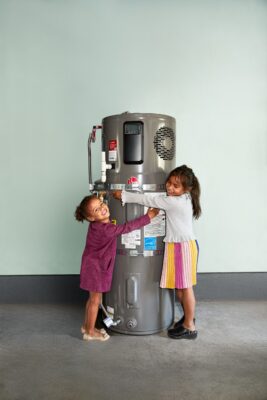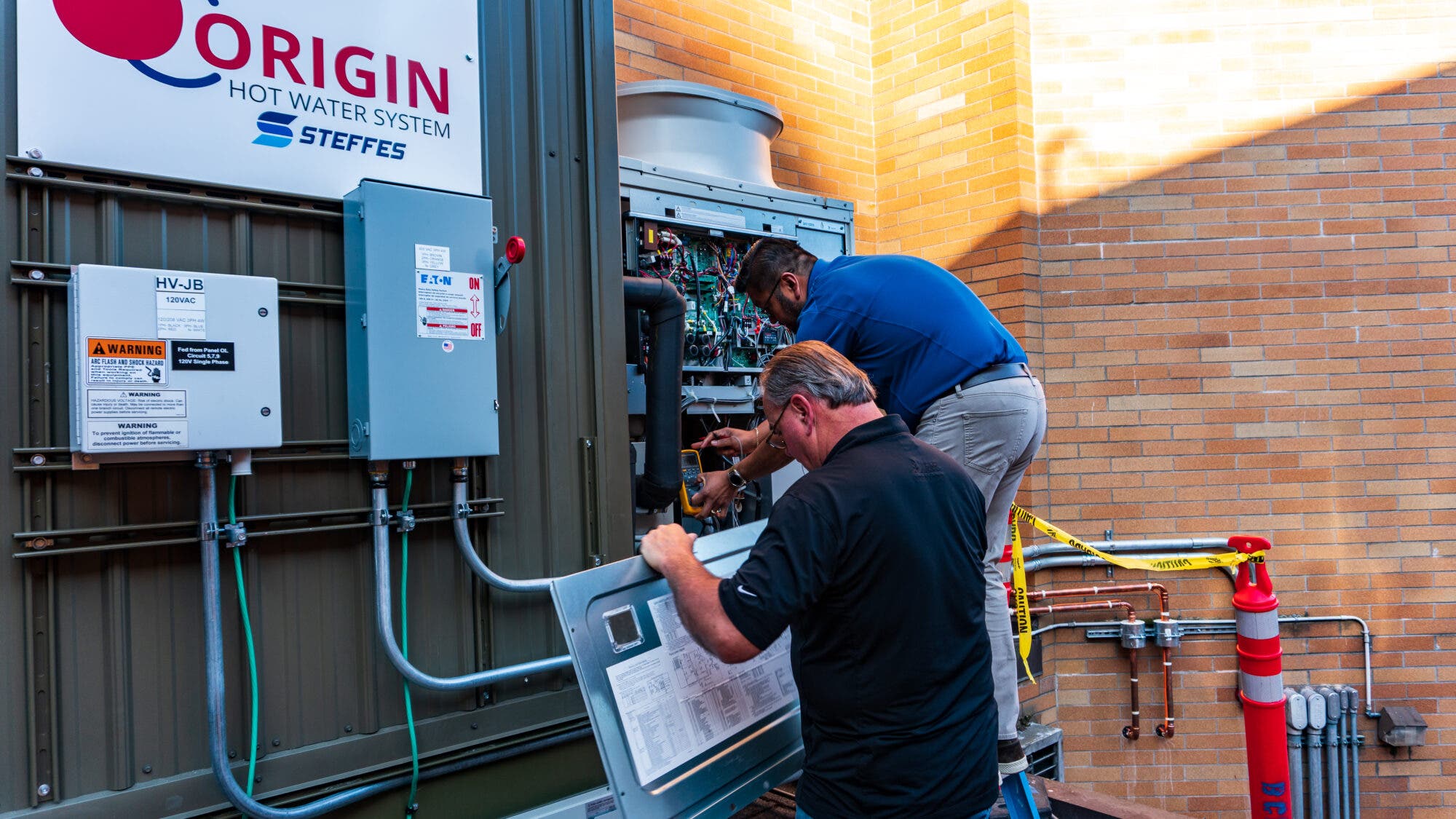Joe Wachunas and Naomi Cole are no strangers to CleanTechnica readers. Both are tireless advocates for the “Electrify Everything” policies of climate advocates like Tony Seba and Mark Jacobson. Heat pump technology is number one on their list of things people can do to lower the carbon footprint of their homes.
“The heat pump is one of the essential technologies for a decarbonized life. It can heat everything — from air to water to laundry — using electricity that can be cleanly powered by renewable energy. They are three to five times more efficient than natural gas, fuel oil or electric resistance systems. They also cool our homes and food (yes, a fridge is a one-way heat pump) which is increasingly important in a warming world,” they wrote recently.
Joe is the project manager for the New Buildings Institute, a nonprofit dedicated to reducing emissions from existing existing homes and buildings. He says the heat pump is “a crucial decarbonizing technology that may not be on many people’s radar screens.” He was an early adopter of the heat pump water heater and he says he’s been “over the moon” about its performance and energy and cost savings.
A Heat Pump Water Heater Is Super Efficient
 What makes a heat pump water heater so special? Exactly the same thing that makes an electric car so special — energy efficiency. If you are a regular reader of CleanTechnica, you know our world is facing a climate emergency because of the billions of tons of greenhouse gases we dump into the environment each year. A typical gasoline powered car turns only about 25% of the energy in a gallon of gas into forward motion. An electric car can turn 90% of the energy stored in its battery into forward motion.
What makes a heat pump water heater so special? Exactly the same thing that makes an electric car so special — energy efficiency. If you are a regular reader of CleanTechnica, you know our world is facing a climate emergency because of the billions of tons of greenhouse gases we dump into the environment each year. A typical gasoline powered car turns only about 25% of the energy in a gallon of gas into forward motion. An electric car can turn 90% of the energy stored in its battery into forward motion.
By the same token, a heat pump hot water heater can be 3 times more efficient than a normal electric water heater. Same amount of hot water at one third the cost. Who wouldn’t take that deal? The most efficient models can use 80 to 85 percent less energy than the least efficient gas and electric-resistance varieties. If used to replace a gas-powered unit, they avoid on average a ton of carbon emissions annually — equivalent to the amount of carbon stored by growing 15 tree seedlings for 10 years, according to Canary Media.
Of course, new technology produced in lower quantities costs more than standard stiff that has been in production for decades. Which means a heat pump water heater costs more to buy. For example, a 50 gallon heat pump water heater from Rheem, a top tier manufacturer, has a list price of $1,699. That’s more than double the $799 price of a top rated 50 gallon electric resistance Rheem water heater. Installation can also cost more for a heat pump water heater, especially when contractors are unfamiliar with them, Joe Wachunas notes.
You Get What You Pay For
Why would anyone pay double? Because there is a difference between an expense and an investment. An investment can pay for itself and then continue to pay dividends in the form of lower utility bills for years. The Environmental Protection Agency estimates a family of four could cut energy costs by about $200 per year if they’re switching from a gas water heater, or nearly $550 per year if switching from a conventional electric water heater.
That adds up to more than $7,000 over the heat pump water heater’s expected 15 year lifetime. Would you spend $800 more to save $7000? Most people would answer yes to that question. Then there are various incentives that can lower the cost and raise the benefits. Many local utilities are giving consumers extra financial incentives to encourage them to switch to heat pump water heaters. Go online to the EPA Energy Star rebate finder for a list of local incentives. It can be well worth digging them up. Residents of Maine, for example, can get an instant rebate that allows them to buy a new heat pump water heater for as little as $429.
All U.S. taxpayers can claim the 25C tax credit to cover 30 percent of the cost (up to $2,000) of the installation and equipment costs for a qualifying Energy Star heat pump water heater. The $2,000 limit resets annually and can be used toward heat-pump HVAC systems as well. So you can get the full value of the tax credit for both upgrades if you do them in different years.
Forthcoming rebates will also make heat pump water heaters more affordable for lower income families in the US. Those rebates will cover the cost of a new heat pump water heater up to $1,750. State energy offices are working now on how they’ll roll out heir rebate programs, which are expected to become available next year.
Central Heat Pump Water Heater Acts Like A Battery

Large central heat pump water heaters (CHPWH) for multi-unit buildings can substantially reduce the amount of energy used in heating hot water and can act as giant thermal batteries. Using energy to heat water during times of low grid demand and storing it for later use means building owners don’t have to draw electricity from the grid during times of peak demand.
Bayview Tower is a low income public housing facility for senior citizens located in downtown Seattle. Hot water for the residents was provided by an inefficient electric resistance water heater which alone accounted for about a third of the building’s electrical use. It was replaced with a CHPWH in the summer of 2021. It supplies hot water to all residents while saving an estimated 135,000 kilowatt hours (kWh) annually. There is also a significant reduction in carbon emissions from not using all that electricity.
As communities, regions, and states electrify buildings and transportation move toward using more solar and wind generated energy, the times when we use electricity become increasingly important. If everyone uses lots of electricity at the same time, utilities must rely on fossil fuel powered plants to provide the extra supply or cut power to some homes.
Using less electricity, storing electricity in batteries, and spreading out or shifting our energy usage are key strategies to help solve this problem and water heating is one of the easiest ways to do all that.
We can “charge” the system by using the efficient heat pump to heat water up during times of low grid demand (or high renewable production), and then use that stored energy during times of high grid demand while still enjoying plenty of hot water. Water heaters in multi-family and commercial buildings can be important players because they have more water storage capacity concentrated in one system.
The team working on the Bayview tower piloted the idea of preheating the water heater hotter than normal during periods with low demand on the grid and then turning it off between typical periods of peak usage from 6:00 to 9:00 AM and PM.
It worked. The building can now essentially cut the energy used during peak times to near zero, which represents a tremendous opportunity at a system level. The amount of power capacity that could be saved if nearly all apartment buildings in California were converted to run on load shifting heat pump water heaters is estimated at 2,000 MW. During times of peak demand, cutting 2,000 MW of power could take a significant chunk off the top of the peak energy usage when fossil fuel power plants are most likely to be needed.
Bayview Tower thus shows how central water heaters hold a vast potential to act as a type of battery, providing more efficient water heating during times of normal operation and completely shifting the times when energy is used for water heating. Building residents get the same comfort and hot water while ensuring a more efficient and greener grid.
The Takeaway
We need to find ways to use electrical energy more wisely. Even ignoring the climate implications of thermal generation, it is just wasteful to use two to three times as much electricity as needed. For generations we have used methane gas or inefficient resistance techniques to heat water. We also once used hand cranks to start our cars. Now we know better.
Heat pump water heaters are widely available now. They are efficient and quite affordable, especially when the energy savings they provide are included. The key is not to wait until your old water heater fails. If it is more than 10 years old, it’s time to start planning to replace it now with a modern, efficient heat pump water heater. You’ll be glad you did.




